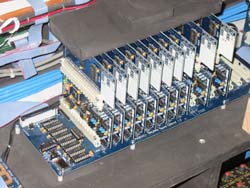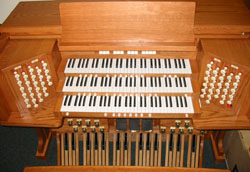What is a ‘digital pipe’ organ

The ‘Digital Pipe’ Organ replaces the traditional generation of musical notes via wind-driven pipes with “long” digital sampling recordings of wind-driven pipes as the musical source to be sent to speakers via an amplifier. Since these note-by-note samples are stored in digital format in a memory bank on a computer processor board that also recreates the original pipe organ note’s audio profile, one can think of these circuit boards (shown on the right) as “digital pipes“. (Note also that the real estate required for digital pipes is somewhat less than for traditional organ pipes.)
The math associated with storing digital samples says that digital sampling, using “long” digital samples, will capture all the nuances associated with the geometry of each organ pipe — and it does just that — even capturing “chiff” associated with wind effects. However, production of genuine traditional pipe organ sounds requires additional attention to detail to create an authentic pipe organ sound experience. Factors such as the physical spread of pipes across a rank, wind effects, temperament and timing delays need to be considered. Phoenix has provided the necessary additional electronics required to take these factors into account.

Although a ‘Digital Pipe’ Organ, the User Interface (the organ console) still needs to be totally familiar to the organist. The Phoenix Organ founders and technical officers are not only electrical engineers but practising organists; they understand what is required in an organ console such that an organist feels completely comfortable at the console of a Phoenix ‘Digital Pipe’ Organ. Multiple keyboards, pedalboards meeting industry standards, thumb and toe pistons are all incorporated into the console.
Finally, the introduction of this technology into organ design opens up many additional possibilities such as providing multiple organ styles (allowing selection between two or three of, say, English, Baroque, French, Romantic, etc.) and allows for the introduction of “temperament” to recreate the sound produced by early organs. It also reduces maintenance operations such as tuning that can be affected by (seasonal) environmental effects such as temperature, humidity and building vibrations.

0 Comments